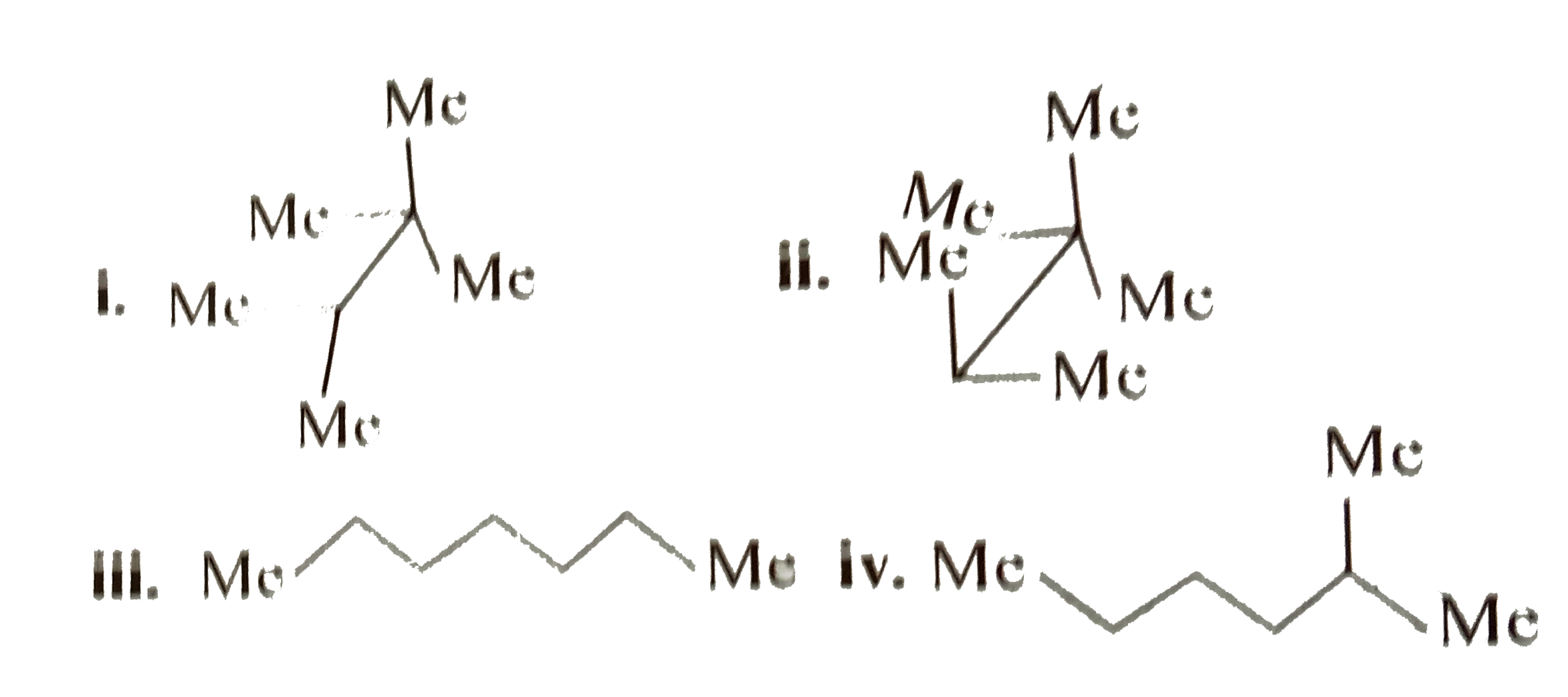Arrange the following according to liquification pressure (n-pentane, iso-pentane, neo-pentane)
To solve the problem of arranging n-pentane, iso-pentane, and neo-pentane according to their liquefaction pressure, we can follow these steps:
Step 1: Understand the Structures
First, we need to identify the structures of the three compounds:
- n-pentane: A straight-chain alkane with the formula CH3-CH2-CH2-CH2-CH3.
- iso-pentane: A branched alkane with the formula CH3-CH(CH3)-CH2-CH3, which has one branch.
- neo-pentane: A more branched alkane with the formula (CH3)4C, having two branches.
Step 2: Analyze Van der Waals Forces
Next, we need to consider the van der Waals forces of attraction in these compounds. The strength of these forces is influenced by the surface area of the molecules:
- n-pentane has the largest surface area due to its straight-chain structure, which allows for more significant van der Waals interactions.
- iso-pentane has a medium surface area because of its one branch, leading to reduced van der Waals forces compared to n-pentane.
- neo-pentane has the smallest surface area due to its highly branched structure, resulting in the weakest van der Waals forces.
Step 3: Order of Van der Waals Forces
Based on the analysis:
- n-pentane > iso-pentane > neo-pentane (in terms of van der Waals forces)
Step 4: Relate Van der Waals Forces to Liquefaction Pressure
Liquefaction pressure is inversely related to the strength of van der Waals forces:
- Higher van der Waals forces → Higher liquefaction pressure
- Lower van der Waals forces → Lower liquefaction pressure
Step 5: Arrange According to Liquefaction Pressure
Now, we can reverse the order of van der Waals forces to get the order of liquefaction pressure:
- Liquefaction pressure: neo-pentane > iso-pentane > n-pentane
Final Answer
The arrangement of the compounds according to their liquefaction pressure is:
1. neo-pentane (highest liquefaction pressure)
2. iso-pentane
3. n-pentane (lowest liquefaction pressure)
---
First, we need to identify the structures of the three compounds:
- n-pentane: A straight-chain alkane with the formula CH3-CH2-CH2-CH2-CH3.
- iso-pentane: A branched alkane with the formula CH3-CH(CH3)-CH2-CH3, which has one branch.
- neo-pentane: A more branched alkane with the formula (CH3)4C, having two branches.
Next, we need to consider the van der Waals forces of attraction in these compounds. The strength of these forces is influenced by the surface area of the molecules:
- n-pentane has the largest surface area due to its straight-chain structure, which allows for more significant van der Waals interactions.
- iso-pentane has a medium surface area because of its one branch, leading to reduced van der Waals forces compared to n-pentane.
- neo-pentane has the smallest surface area due to its highly branched structure, resulting in the weakest van der Waals forces.
Based on the analysis:
- n-pentane > iso-pentane > neo-pentane (in terms of van der Waals forces)
Liquefaction pressure is inversely related to the strength of van der Waals forces:
- Higher van der Waals forces → Higher liquefaction pressure
- Lower van der Waals forces → Lower liquefaction pressure
Now, we can reverse the order of van der Waals forces to get the order of liquefaction pressure:
- Liquefaction pressure: neo-pentane > iso-pentane > n-pentane
The arrangement of the compounds according to their liquefaction pressure is:
1. neo-pentane (highest liquefaction pressure)
2. iso-pentane
3. n-pentane (lowest liquefaction pressure)
Topper's Solved these Questions
- BOOK - RESONANCE ENGLISHCHAPTER - GASEOUS STATEEXERCISE - Exercise-21videos
GASEOUS STATE
- BOOK - RESONANCE ENGLISHCHAPTER - GASEOUS STATEEXERCISE - Exercise72videos
GASEOUS STATE
- BOOK - RESONANCE ENGLISHCHAPTER - GASEOUS STATEEXERCISE - Exercise-31videos
GASEOUS STATE
- BOOK - RESONANCE ENGLISHCHAPTER - FUNDAMENTAL CONCEPTEXERCISE - ORGANIC CHEMISTRY(Fundamental Concept )40videos
FUNDAMENTAL CONCEPT
- BOOK - RESONANCE ENGLISHCHAPTER - HYDROCARBONEXERCISE - ORGANIC CHEMISTRY(Hydrocarbon)50videos
HYDROCARBON
Similar Questions
Knowledge Check
- Question 1 - Select One
Arrange the following compounds in increasing order of boiling point :
Prpane-1-ol, butan-1-ol, butan-2-ol, pentan-1-olAPropan-1- ol, butan -1-ol, butan-1-ol, pentan -1-olBPentan-1-ol,butan-2-ol, butan-1-ol,propan -1-olCPentan-1-ol,butan- 2- ol, butan -1-ol, propan-1-olDPentan-1-ol,butan-1-ol, butan-2-ol,propan-1-ol - Question 2 - Select One
Arrange the following compounds in increasing order of boiling point :
Prpane-1-ol, butan-1-ol, butan-2-ol, pentan-1-olAPropan-1- ol, butan -1-ol, butan-1-ol, pentan -1-olBPentan-1-ol,butan-2-ol, butan-1-ol,propan -1-olCPentan-1-ol,butan- 2- ol, butan -1-ol, propan-1-olDPentan-1-ol,butan-1-ol, butan-2-ol,propan-1-ol - Question 3 - Select One
Arrange the following in decreasing order of their boiling points:
(I) n-Butane
(II) 2-Methylbutane,
(III) n-Pentane
(IV) 2,2-DimethylpropaneAIgtIIgtIIIgtIVBIIgtIIIgtIVgtICIVgtIIIgtIIgtIDIIIgtIIgtIVgtI
Arrange the following compounds in increasing order of boiling point :
Prpane-1-ol, butan-1-ol, butan-2-ol, pentan-1-olView SolutionArrange the following sets of compounds in order of their increasing boiling points:
(a) Pentan-1-ol, butan-1-ol, butan-2-ol, ethanol, propan-1-ol, methanol.
(b) Pentan-1-ol, n-butane, pentanal, ethoxyethane.View SolutionArrange the following in order of decreasing boiling points
(i) Pentan-1-ol (ii) 2-Methylbutan-2-ol, (iii) 3-Methylbutan-2-ol.View SolutionArrange the following in decreasing order of their boiling points.
(A). N-butane
(B). 2-methylbutane
(C). N-pentane
(D). 2,2-dimethylpropaneView SolutionHow will you distinguish pentane from 1-pentene ?
View Solution


